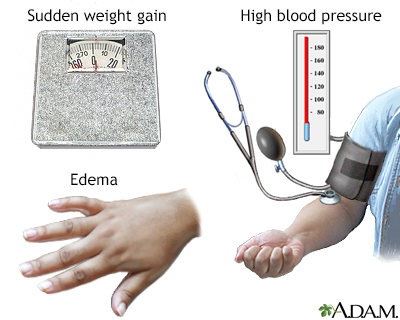Pregnancy SmartSiteTM
Toxemia - self-care; PIH - self-care; Pregnancy-induced hypertension - self-care DescriptionPregnant women with preeclampsia have high blood pressure and signs of liver or kidney damage. Kidney damage results in the presence of protein in the urine. Preeclampsia that occurs in women after the 20th week of pregnancy can be mild or severe. Preeclampsia usually resolves after the baby is born and the placenta is delivered. However, it may persist or even begin after delivery, most often within 48 hours. This is called postpartum preeclampsia. What to ExpectTreatment decisions are made based on the gestational age of the pregnancy and the severity of the preeclampsia. If you are past 37 weeks and have been diagnosed with preeclampsia, your health care provider will likely advise you to deliver early. This may involve receiving medicines to start (induce) labor or delivering your baby by cesarean delivery (C-section). If you are less than 37 weeks pregnant, the goal is to prolong your pregnancy as long as it is safe. Doing so allows your baby to develop longer inside you.
Complete bed rest is no longer recommended. Your provider will recommend an activity level for you. Self-care at HomeWhen you are at home, your provider will tell you what changes you may need to make in your diet. You may need to take medicines to lower your blood pressure. Take these medicines the way your provider tells you to. Do not take any extra vitamins, calcium, aspirin, or other medicines without talking with your provider first. Often, women who have preeclampsia do not feel sick or have any symptoms. Still, both you and your baby may be in danger. To protect yourself and your baby, it's important to go to all of your prenatal visits. If you notice any symptoms of preeclampsia (listed below), tell your provider right away. Risks of PreeclampsiaThere are risks to both you and your baby if you develop preeclampsia:
Monitoring You and Your BabyWhile you are home, your provider may ask you to:
Your provider will teach you how to do these things. You will need frequent visits with your provider to make sure you and your baby are doing well. You will likely have:
Sign and symptoms of preeclampsia most often go away within 6 weeks after delivery. However, the high blood pressure sometimes gets worse the first few days after delivery. You are still at risk for preeclampsia up to 6 weeks after delivery. This postpartum preeclampsia carries a higher risk of death. It's important to continue monitoring yourself during this time. If you notice any symptoms of preeclampsia, before or after delivery, contact your provider right away. When to Call the DoctorContact your provider right away if you:
ReferencesAmerican College of Obstetricians and Gynecologists website. Gestational hypertension and preeclampsia: ACOG Practice Bulletin, Number 222. Obstet Gynecol. 2020;135(6):e237-e260. PMID: 32443079 pubmed.ncbi.nlm.nih.gov/32443079/. Harper LM, Tita A, Karumanchi SA. Pregnancy-related hypertension. In: Lockwood CJ, Copel JA, Dugoff L, et al, eds. Creasy and Resnik's Maternal-Fetal Medicine: Principles and Practice. 9th ed. Philadelphia, PA: Elsevier; 2023:chap 45. Jeyabalan A. Hypertensive disorders of pregnancy. In: Martin RJ, Fanaroff AA, eds. Fanaroff and Martin's Neonatal-Perinatal Medicine. 12th ed. Philadelphia, PA: Elsevier; 2025:chap 16. Sibai BM. Preeclampsia and hypertensive disorders. In: Landon MB, Galan HL, Jauniaux ERM, et al, eds. Gabbe's Obstetrics: Normal and Problem Pregnancies. 8th ed. Philadelphia, PA: Elsevier; 2021:chap 38. | ||
| ||
Review Date: 10/15/2024 Reviewed By: John D. Jacobson, MD, Professor Emeritus, Department of Obstetrics and Gynecology, Loma Linda University School of Medicine, Loma Linda, CA. Also reviewed by David C. Dugdale, MD, Medical Director, Brenda Conaway, Editorial Director, and the A.D.A.M. Editorial team. View References The information provided herein should not be used during any medical emergency or for the diagnosis or treatment of any medical condition. A licensed medical professional should be consulted for diagnosis and treatment of any and all medical conditions. Links to other sites are provided for information only -- they do not constitute endorsements of those other sites. No warranty of any kind, either expressed or implied, is made as to the accuracy, reliability, timeliness, or correctness of any translations made by a third-party service of the information provided herein into any other language. © 1997- A.D.A.M., a business unit of Ebix, Inc. Any duplication or distribution of the information contained herein is strictly prohibited. | ||


 Preeclampsia
Preeclampsia
